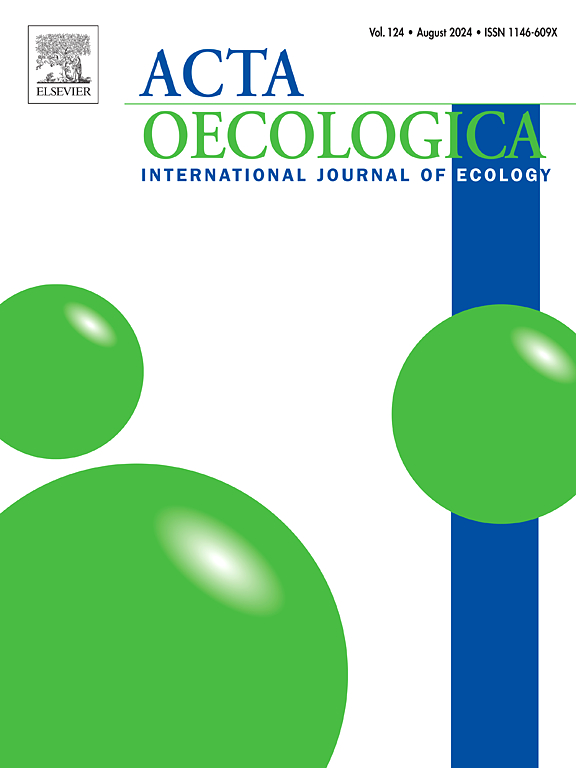我们对巴西食肉动物的种子传播了解多少?
IF 1.3
4区 环境科学与生态学
Q3 ECOLOGY
Acta Oecologica-International Journal of Ecology
Pub Date : 2025-03-20
DOI:10.1016/j.actao.2025.104073
引用次数: 0
摘要
种子传播在资源供应和气候调节中发挥着关键作用,但这种相互作用受到栖息地破碎化、物种丧失和种群减少的威胁。食肉哺乳动物通过捕食者等多种角色对生态系统功能做出了重大贡献,但它们作为种子传播者的作用尚未得到充分了解。我们评估了知识的状态,并确定了在巴西发生的杂食性食肉动物种子传播方面的差距。通过系统的文献综述,研究了食肉动物-水果在传播循环的四个阶段的相互作用,即:1)食果和食性;2)种子通过消化道;3)种子沉积模式;4)对幼苗建立的影响。通过对53篇论文的分析,我们发现3种(Cerdocyon thous, Nasua Nasua和Potos flavus)的研究集中在60%以上,其余8种的研究较少。研究主要集中在人口最多的城市地区的大西洋森林,没有对潘塔纳尔生物群落进行研究。尽管如此,仍有大片地区未被勘探。尽管近年来人们对食肉动物与果实的相互作用越来越感兴趣,但只有一项研究解决了传播循环的四个阶段,这使得我们无法比较种子在不同物种之间的传播效果。食肉动物与132种植物相互作用,种子传播距离为0.35 ~ 340 m,平均种子发芽率为48%。我们讨论了已确定的知识缺口的潜在解释,并提出了填补这一生物多样性缺口的方法,强调需要更全面的研究来建立食肉动物在种子传播生态学中所起作用的坚实基础。本文章由计算机程序翻译,如有差异,请以英文原文为准。
What do we know about seed dispersal by Carnivorans in Brazil?
Seed dispersal plays a key role in resource provision and climate regulation, yet this interaction is threatened by habitat fragmentation, species loss and population declines. Carnivoran mammals contribute substantially to ecosystem functioning through various roles such as predators, but their role as seed dispersers is not well-understood. We assessed the state-of-knowledge and identified gaps regarding seed dispersal by omnivorous Carnivora that occur in Brazil. A systematic literature review was conducted to examine Carnivora–fruit interactions across four stages of the dispersal loop, namely: 1) frugivory and diet; 2) seed passage through the digestive tract; 3) patterns of seed deposition; and 4) their impact on seedling establishment. Based on 53 papers we found that three species (Cerdocyon thous, Nasua nasua and Potos flavus) concentrated more than 60 % of the studies, with the remaining eight species received less attention. Studies were largely concentrated in the Atlantic Forest, in most populated urban areas, with no studies conducted in the Pantanal biome. Still, large areas remained unexplored. Despite increasing interest in Carnivora–fruit interactions in the last years, only one study addressed the four stages of the dispersal loop, preventing us to compare seed dispersal effectiveness across species. Carnivorans interacted with 132 plant species, dispersing seeds from 0.35 to 340 m, with average seed germination of 48 %. We discussed potential explanations for the identified knowledge gaps and propose ways to fill this biodiversity shortfall, emphasizing the need for more comprehensive studies to establish a robust foundation of the role played by Carnivora in seed dispersal ecology.
求助全文
通过发布文献求助,成功后即可免费获取论文全文。
去求助
来源期刊
CiteScore
3.60
自引率
0.00%
发文量
57
审稿时长
>0 weeks
期刊介绍:
Acta Oecologica is venue for the publication of original research articles in ecology. We encourage studies in all areas of ecology, including ecosystem ecology, community ecology, population ecology, conservation ecology and evolutionary ecology. There is no bias with respect to taxon, biome or geographic area. Both theoretical and empirical papers are welcome, but combinations are particularly sought. Priority is given to papers based on explicitly stated hypotheses. Acta Oecologica also accepts review papers.

 求助内容:
求助内容: 应助结果提醒方式:
应助结果提醒方式:


